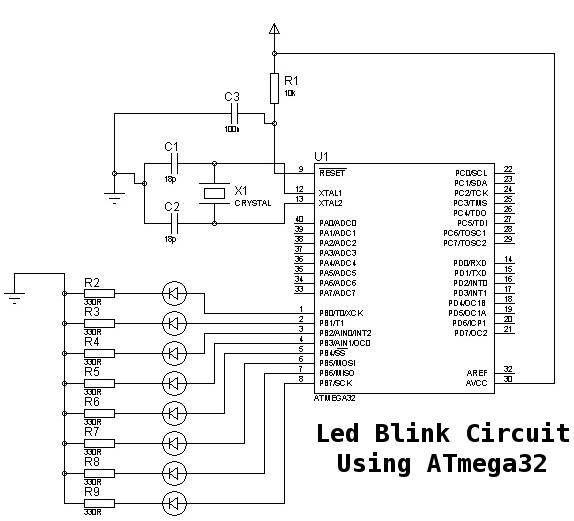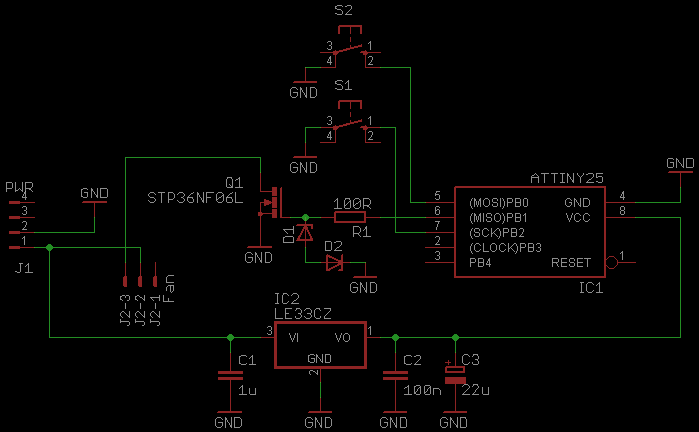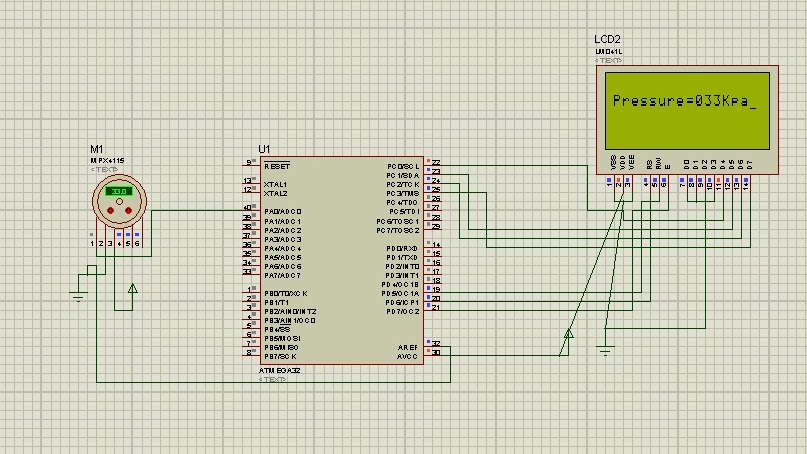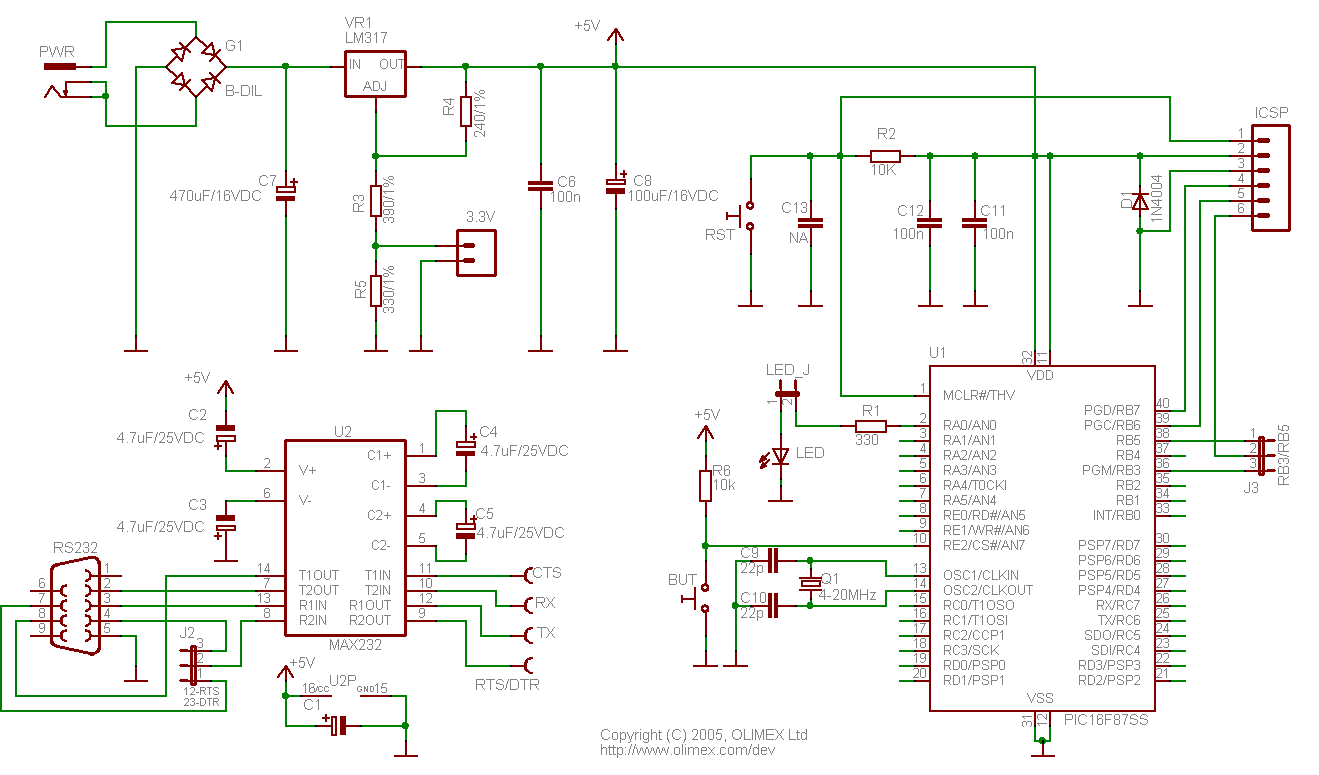
AVR Development Board
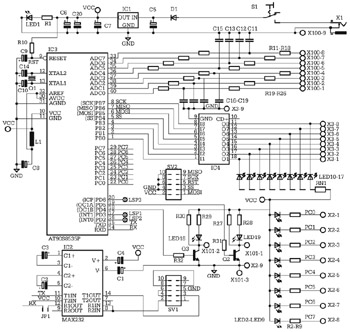
The microcontroller is an AT90S8535-P in a DIP40 package. It is pin-compatible with other members of the AVR analog series, such as the ATMega8535 and ATMega16, although there are significant differences among them. It is advisable to consult the data sheets prior to making any substitutions. The external clock circuit employs an 8 MHz crystal (Q1) along with capacitors C10 and C11 (12-47 pF). The RESET circuit comprises a resistor (R1, 10 K) and a capacitor (C1, 10 µF/10 V). These component values are not critical, as the AT90S8535 includes internal signal conditioning circuits for the RESET signal. The digital input lines are connected to PORTC and are pulled up to Vcc with resistors. A group of LEDs is included to indicate the status of each input. The idle state of the input lines is HIGH, and an input line becomes active when pulled to GND (for instance, by a relay contact), causing the corresponding LED to illuminate.
The AT90S8535-P microcontroller, housed in a DIP40 package, is a versatile component suitable for various embedded applications. Its pin compatibility with other AVR microcontrollers, such as the ATMega8535 and ATMega16, allows for easy integration into existing designs, albeit with careful consideration of their differing specifications.
The external clock circuit is crucial for the microcontroller's operation, utilizing an 8 MHz crystal (designated as Q1) paired with capacitors C10 and C11, which should be selected within the range of 12 to 47 pF to ensure stable oscillation. The choice of these capacitors is influenced by the crystal's specifications and the desired frequency stability.
The RESET circuit is designed for reliable operation, comprising a 10 KΩ resistor (R1) and a 10 µF capacitor (C1) rated for 10 V. While these component values are not critical due to the internal signal conditioning capabilities of the AT90S8535, they provide additional robustness against noise and voltage fluctuations during startup.
Digital input lines are interfaced through PORTC, with pull-up resistors connected to Vcc to maintain a HIGH idle state. This configuration allows for reliable detection of input signals, where an active input line is established when the line is pulled to ground, typically achieved through a relay contact. The inclusion of status-indicating LEDs enhances the design by providing visual feedback on the state of each input, facilitating debugging and operational monitoring.
Overall, the AT90S8535-P microcontroller, combined with its supporting circuitry, offers a robust platform for various applications, with careful attention to component selection and circuit design ensuring reliable performance.The microcontroller is an AT90S8535-P in a DIP40 package. Note that this microcontroller is pin by pin, hardware compatible with other members of the analog series of AVR microcontrollers, like ATMega8535 and ATMega16. However, there are many differences between these microcontrollers. Consult the data sheets before making the replacement. The ext ernal clock circuit uses an 8 MHz crystal, Q1, and the capacitors C10, C11 (12 47 pF). The RESET circuit consists of the resistor R1 (10 K), and the capacitor C1 (10 F/10 V). These values are not critical, because AT90S8535 contains internal signal conditioning circuits for the RESET signal. The digital input lines are connected to PORTC, and are pulled up to V cc with resistors. A group of LEDs has been included, to show the status of each input. The idle status of the input lines is HIGH. An input line is active when pulled to GND (for example by the contact of a relay). In this case, the associated LED will light, indicating the. 🔗 External reference
The AT90S8535-P microcontroller, housed in a DIP40 package, is a versatile component suitable for various embedded applications. Its pin compatibility with other AVR microcontrollers, such as the ATMega8535 and ATMega16, allows for easy integration into existing designs, albeit with careful consideration of their differing specifications.
The external clock circuit is crucial for the microcontroller's operation, utilizing an 8 MHz crystal (designated as Q1) paired with capacitors C10 and C11, which should be selected within the range of 12 to 47 pF to ensure stable oscillation. The choice of these capacitors is influenced by the crystal's specifications and the desired frequency stability.
The RESET circuit is designed for reliable operation, comprising a 10 KΩ resistor (R1) and a 10 µF capacitor (C1) rated for 10 V. While these component values are not critical due to the internal signal conditioning capabilities of the AT90S8535, they provide additional robustness against noise and voltage fluctuations during startup.
Digital input lines are interfaced through PORTC, with pull-up resistors connected to Vcc to maintain a HIGH idle state. This configuration allows for reliable detection of input signals, where an active input line is established when the line is pulled to ground, typically achieved through a relay contact. The inclusion of status-indicating LEDs enhances the design by providing visual feedback on the state of each input, facilitating debugging and operational monitoring.
Overall, the AT90S8535-P microcontroller, combined with its supporting circuitry, offers a robust platform for various applications, with careful attention to component selection and circuit design ensuring reliable performance.The microcontroller is an AT90S8535-P in a DIP40 package. Note that this microcontroller is pin by pin, hardware compatible with other members of the analog series of AVR microcontrollers, like ATMega8535 and ATMega16. However, there are many differences between these microcontrollers. Consult the data sheets before making the replacement. The ext ernal clock circuit uses an 8 MHz crystal, Q1, and the capacitors C10, C11 (12 47 pF). The RESET circuit consists of the resistor R1 (10 K), and the capacitor C1 (10 F/10 V). These values are not critical, because AT90S8535 contains internal signal conditioning circuits for the RESET signal. The digital input lines are connected to PORTC, and are pulled up to V cc with resistors. A group of LEDs has been included, to show the status of each input. The idle status of the input lines is HIGH. An input line is active when pulled to GND (for example by the contact of a relay). In this case, the associated LED will light, indicating the. 🔗 External reference
